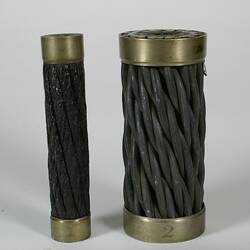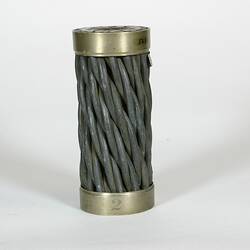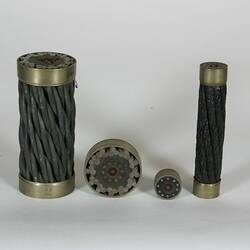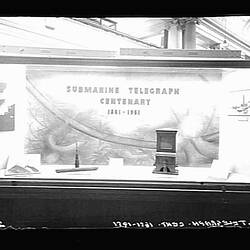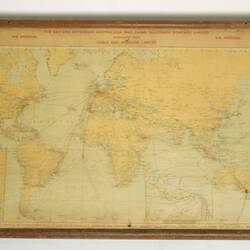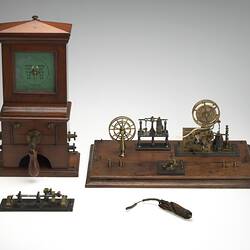Summary
One of four sections of the Atlantic Submarine Telegraph cable laid in 1865, some 2300 nautical miles.
This object is an unused sample of the shore end of the cable. The shore end was more heavily armoured than the main cable because of the greater possibility of damage close to shore by wave action and fishing and anchoring activities.
The donor of these items was the Telegraph Construction & Maintenance Co, London, England, who manufactured the 1865 cable.
Physical Description
Length of metal cable showing the inside along both cut ends. Each end of the the sample is fitted with a circumferential metal band. The folllowing description is based on that given in the book "The Atlantic Telegraph", by W. H. Russell, first published in 1866, republished in 2005 by Nonsuch Publishing Ltd. The copper conductor at the centre of the cable was a strand of seven copper wires, each of No. 18 BWG (Birmingham Wire Gauge), or 1.25 mm diameter. The central wire was covered with a thick coating of Chatterton's Compound, a mixture of gutta percha and Stockholm tar, so that when the other six wires were wrapped spirally round it all gaps between the wires were filled. The conductor was then surrounded by a layer of pure gutta percha followed a layer of Chatterton's Compound. The process was repeated three more times to give a total of four layers of gutta percha and four layers of Compound. The core consisting of the conductor and its layers of insulation were wrapped with jute and the whole was armoured by wrapping ten iron wires spirally round the core. Each of these wires was itself covered with a jacket of tarred Manilla yarn. This completed the structure of the main cable. The shore end cable was further protected by an additional armouring of twelve strands of iron wire, each strand consisting of three wires of No. 2 BWG, or 7.21 mm diameter.
Significance
These cable sections are unused samples of the cable used in the first long term telegraphic connection across the Atlantic Ocean. The cable became operational in 1865.
More Information
-
Collection Names
-
Collecting Areas
-
Acquisition Information
Donation from Telegraph Construction & Maintenance Co
-
Manufacturer
Telegraph Construction & Maintenance Co, London, England, Great Britain, circa 1865
-
Inscriptions
One band is inscribed with the numeral '2'.
-
Classification
-
Category
-
Discipline
-
Type of item
-
Overall Dimensions
150 mm (Length), 64 mm (Outside Diameter)
Diameter is measured across the cuircumferential end bands.
-
References
"The Atlantic Telegraph", by W. H. Russell, first published in 1866, republished in 2005 by Nonsuch Publishing Ltd.
-
Keywords

